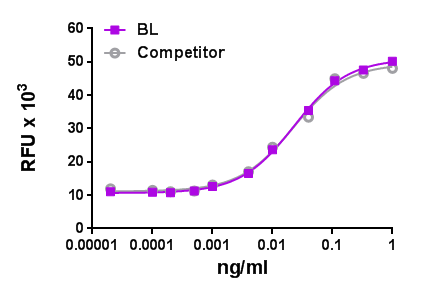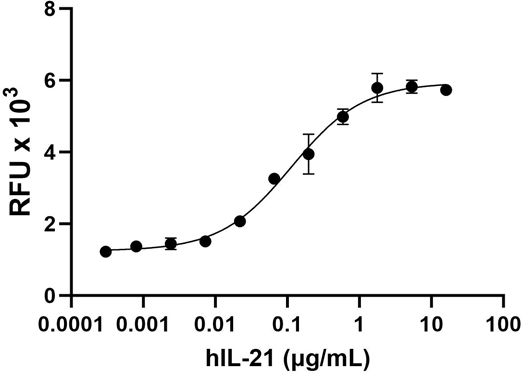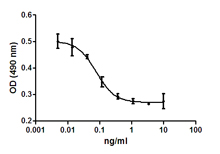- Regulatory Status
- RUO
- Other Names
- Cytokine synthesis inhibitory factor (CSIF)
- Ave. Rating
- Submit a Review
| Cat # | Size | Price | Quantity Check Availability | Save | ||
|---|---|---|---|---|---|---|
| 715602 | 10 µg | $253 | ||||
This product is not available for shipping outside of the United States.
IL-10 was first described as a cytokine that is produced by T helper 2 (Th2) cell clones. It inhibits IFN-γ synthesis in Th1 cells, and therefore it was initially called cytokine synthesis inhibiting factor (CSIF). Macrophages are the main source of IL-10 and its secretion can be stimulated by endotoxin (via Toll-like receptor 4, NF-kB dependent), tumor necrosis factor TNF-α (via TNF receptor p55, NF-κB-dependent), catecholamines, and IL-1. IL-10 controls inflammatory processes by suppressing the expression of proinflammatory cytokines, chemokines, adhesion molecules as well as antigen-presenting and costimulatory molecules in monocytes/macrophages, neutrophils, and T cells. IL-10 inhibits the production of proinflammatory mediators by monocytes and macrophages such as endotoxin- and IFNγ-induced release of IL-1α, IL-6, IL-8, G-CSF, GM-CSF, and TNF-α. In addition, it enhances the production of anti-inflammatory mediators such as IL-1RA and soluble TNF-α receptors. IL-10 inhibits the capacity of monocytes and macrophages to present antigen to T cells. This is realized by downregulation of constitutive and IFNγ-induced cell surface levels of MHC class II, of costimulatory molecules such as CD86 and of some adhesion molecules such as CD58. IL-10 belongs to a family of nine members: IL-10, IL-19, IL-20, IL-22, IL-24, IL-26, and the more distantly related IL-28A, IL-28B, and IL-29. This family of cytokines emerged before the adaptive immune response.
Product DetailsProduct Details
- Source
- Human IL-10, amino acids Ser19-Asn178 (Accession# NM_000572), was expressed in E.coli.
- Molecular Mass
- The 161 amino acid N-terminal methionylated recombinant protein has a predicted molecular mass of 18.8 kD. The predicted N-terminal amino acid is Met.
- Purity
- >98%, as determined by Coomassie stained SDS-PAGE and HPLC analysis.
- Formulation
- Lyophilized, carrier-free.
- Endotoxin Level
- Less than 0.1 ng per µg of protein.
- Storage & Handling
- Unopened vial can be stored at -20°C or -70°C. For maximum results, quick spin vial prior to opening. Reconstitute in water to a concentration of 0.1-1.0 mg/ml. Do not vortex. It is recommended to further dilute in a buffer, such as 5% Trehalose, and store working aliquots at -20°C to -80°C. Avoid repeated freeze/thaw cycles.
- Activity
- ED50 is ≤ 2.0 ng/ml, corresponding to a specific activity of ≥ 5.0 x 105 units/mg as determined by the dose-dependent co-stimulation (with human IL-4) of MC/9 cells.
- Application
-
Bioassay
Antigen Details
- Distribution
- IL-10 is produce by Th2 cells, macrophages, dendritic cells, B cells, CD8+ T cells, regulatory T cells (Tregs), Th1 cells and Th17 cells. In addition, IL-10 is expressed by monocytes, B cells, eosinophils, and mast cells.
- Function
- IL-10 is an immunoregulatory cytokine. Its main function is the limitation and termination of inflammatory responses and the regulation of differentiation and proliferation of several immune cells such as T cells, B cells, natural killer cells, antigen presenting cells, mast cells, and granulocytes.
- Interaction
- IL-10R is expressed in monocytes, NK, B and T cells. In addition, Langerhans cells, dermal dendritic cells, eosinophils, mast cells, and endothelial cells can respond to IL-10.
- Ligand/Receptor
- IL-10 binds to their receptors IL-10R1 and IL-10R2, and initiates a STAT3-dependent signaling cascade.
- Biology Area
- Immunology, Cell Biology
- Molecular Family
- Cytokines/Chemokines
- Antigen References
-
1. Fiorentino DF, et al. 1989. J. Exp. Med. 170:2081.
2. Ho AS, et al. 1993. P. Natl. Acad. Sci. USA 90:11267.
3. Hart PH, et al. 1996. J. Immunol. 157:3672.
4. Asadullah K, et al. 2003. Pharmacol. Rev. 55:241.
5. Mosser DM and Zhang X. 2008. Immunol. Rev. 226:205.
6. Maynard CL and Weaver CT. 2008. Immunol. Rev. 226:219.
7. Ouyang W, et al. 2010. Annu. Rev. Immunol. 30:559. - Gene ID
- 3586 View all products for this Gene ID
- UniProt
- View information about IL-10 on UniProt.org
Related FAQs
- Why choose BioLegend recombinant proteins?
-
• Each lot of product is quality-tested for bioactivity as indicated on the data sheet.
• Greater than 95% Purity or higher, tested on every lot of product.
• 100% Satisfaction Guarantee for quality performance, stability, and consistency.
• Ready-to-use liquid format saves time and reduces challenges associated with reconstitution.
• Bulk and customization available. Contact us.
• Learn more about our Recombinant Proteins. - How does the activity of your recombinant proteins compare to competitors?
-
We quality control each and every lot of recombinant protein. Not only do we check its bioactivity, but we also compare it against other commercially available recombinant proteins. We make sure each recombinant protein’s activity is at least as good as or better than the competition’s. In order to provide you with the best possible product, we ensure that our testing process is rigorous and thorough. If you’re curious and eager to make the switch to BioLegend recombinants, contact your sales representative today!
- What is the specific activity or ED50 of my recombinant protein?
-
The specific activity range of the protein is indicated on the product datasheets. Because the exact activity values on a per unit basis can largely fluctuate depending on a number of factors, including the nature of the assay, cell density, age of cells/passage number, culture media used, and end user technique, the specific activity is best defined as a range and we guarantee the specific activity of all our lots will be within the range indicated on the datasheet. Please note this only applies to recombinants labeled for use in bioassays. ELISA standard recombinant proteins are not recommended for bioassay usage as they are not tested for these applications.
- Have your recombinants been tested for stability?
-
Our testing shows that the recombinant proteins are able to withstand room temperature for a week without losing activity. In addition the recombinant proteins were also found to withstand four cycles of freeze and thaw without losing activity.
- Does specific activity of a recombinant protein vary between lots?
-
Specific activity will vary for each lot and for the type of experiment that is done to validate it, but all passed lots will have activity within the established ED50 range for the product and we guarantee that our products will have lot-to-lot consistency. Please conduct an experiment-specific validation to find the optimal ED50 for your system.
- How do you convert activity as an ED50 in ng/ml to a specific activity in Units/mg?
-
Use formula Specific activity (Units/mg) = 10^6/ ED50 (ng/mL)

 Login/Register
Login/Register 
















Follow Us